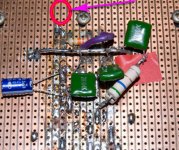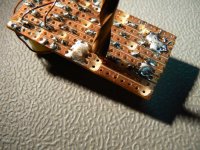Hi, can you measure the resistance across the input ( centre of rca to the outside of the rca), with it turned off and no source connected, is it about 23k? What is it with the source connected..
its 23k when the source is not connected, 15k when a source is connected ( source is switched off and in this state there still is a buzz from the amp) and when the source is powered up (but in standby mode) the resistance is varing between 1 to 6 ohms.
I suggest connecting an open (without barrel) RCA plug to your RCA plug to determine signal and ground pins. You may have got this mixed up.
Just a note... It is very hard to see where your tracks are cut, the easy way would be to buy the special tool, or you could just use a 5mm drill, twisted by hand where you need the break in the track to be..
Please ignore and sorry if you already know this..
Please ignore and sorry if you already know this..
Attachments
danielnaveen,
disconnect the source,try to use a wire connect the 2 input's passive terminal(sginal ground) and watch what happens.
z
disconnect the source,try to use a wire connect the 2 input's passive terminal(sginal ground) and watch what happens.
z
I've mounted the amp on a chassis and everything has been grounded through the chassis. the problem is now gone. Thanks for all you help
Noise with no input
Hello Daniel. Putting ANY resistor between the input and ground will decrease the amount of noise you hear with no input. Everybody starts from the beginning and that may be near where you are, experience wise. As an electric guitar player with many years of plugging and unplugging, I've heard lots of buzzes & hum with no guitar plugged in to an amp.
Think about it, you have this really eager little IC amp just dying to amplify something and there is no input. So the input wire is an antenna - an electronic nose - picking up everything that may be floating by in your local electro-magnetosphere and amplifies it! With no load to flow through, the weakest fields enter the input lead, even though they have no "push" (current) behind them. The magnetic field around the AC power wires in the house, the flashing of the flouresent lights (I have a flourescent bulb that turns up the volume via the IR remote control sensor on a commercial amp of mine), even a cell phone hunting for a local transponder. All the little bits of electonic fluff look like real signals to an "open" input wire, since there is no load for them to flow through and demonstrate that they are almost nothing at all.
I spent months trying to find out where a persistant, rhythmic, electronic noise was coming from. It was ruining my short wave radio reception. It was an ageing neon bulb in an illuminated wall switch! It was connected to a flourescent fixture and was oscillating due to the resistance and capacitance inherent in the fixture.
If you didn't know a snowflake had almost no mass, the sight of a white object flying straight toward your eye would be frightening. Any amp worth its salt will pickup noise with its input "in the air." Your experienced DIYers just forgot this. Persevere.
Hello Daniel. Putting ANY resistor between the input and ground will decrease the amount of noise you hear with no input. Everybody starts from the beginning and that may be near where you are, experience wise. As an electric guitar player with many years of plugging and unplugging, I've heard lots of buzzes & hum with no guitar plugged in to an amp.
Think about it, you have this really eager little IC amp just dying to amplify something and there is no input. So the input wire is an antenna - an electronic nose - picking up everything that may be floating by in your local electro-magnetosphere and amplifies it! With no load to flow through, the weakest fields enter the input lead, even though they have no "push" (current) behind them. The magnetic field around the AC power wires in the house, the flashing of the flouresent lights (I have a flourescent bulb that turns up the volume via the IR remote control sensor on a commercial amp of mine), even a cell phone hunting for a local transponder. All the little bits of electonic fluff look like real signals to an "open" input wire, since there is no load for them to flow through and demonstrate that they are almost nothing at all.
I spent months trying to find out where a persistant, rhythmic, electronic noise was coming from. It was ruining my short wave radio reception. It was an ageing neon bulb in an illuminated wall switch! It was connected to a flourescent fixture and was oscillating due to the resistance and capacitance inherent in the fixture.
If you didn't know a snowflake had almost no mass, the sight of a white object flying straight toward your eye would be frightening. Any amp worth its salt will pickup noise with its input "in the air." Your experienced DIYers just forgot this. Persevere.
I've mounted the amp on a chassis and everything has been grounded through the chassis. the problem is now gone. Thanks for all you help
What do you grounded to the chassis/earth?
- Status
- Not open for further replies.
- Home
- Amplifiers
- Chip Amps
- LM3886 chip amp help

